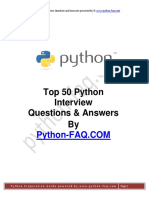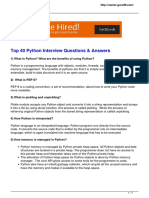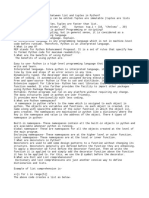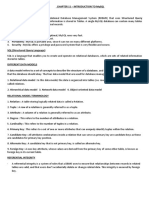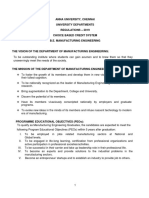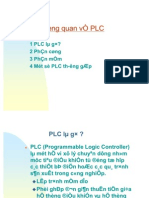0 ratings0% found this document useful (0 votes)
16 viewsDNN 8 Ziku HV
DNN 8 Ziku HV
Uploaded by
Santosh GobheCopyright:
© All Rights Reserved
Available Formats
Download as PDF, TXT or read online from Scribd
DNN 8 Ziku HV
DNN 8 Ziku HV
Uploaded by
Santosh Gobhe0 ratings0% found this document useful (0 votes)
16 views5 pagesOriginal Title
DNn8zikuHv
Copyright
© © All Rights Reserved
Available Formats
PDF, TXT or read online from Scribd
Share this document
Did you find this document useful?
Is this content inappropriate?
Copyright:
© All Rights Reserved
Available Formats
Download as PDF, TXT or read online from Scribd
Download as pdf or txt
0 ratings0% found this document useful (0 votes)
16 views5 pagesDNN 8 Ziku HV
DNN 8 Ziku HV
Uploaded by
Santosh GobheCopyright:
© All Rights Reserved
Available Formats
Download as PDF, TXT or read online from Scribd
Download as pdf or txt
You are on page 1of 5
1. What is Python? List some popular applications of Python in the world of technology.
Python is a widely-used general-purpose, high-level
programming language. It was created by Guido van Rossum in 1991 and further developed by the Python Software Foundation. It was
designed with an emphasis on code readability, and its syntax allows programmers to express their concepts in fewer lines of code. It is used
for: System Scripting Web Development Game Development Software Development Complex Mathematics 2. What are the benefits of using
Python language as a tool in the present scenario? The following are the benefits of using Python language: Object-Oriented Language High-
Level Language Dynamically Typed language Extensive support for Machine Learning Libraries Presence of third-party modules Open source
and community development Portable and Interactive Portable across Operating systems 3. Is Python a compiled language or an interpreted
language? Actually, Python is a partially compiled language and partially interpreted language. The compilation part is done first when we
execute our code and this will generate byte code internally this byte code gets converted by the Python virtual machine(p.v.m) according to the
underlying platform(machine+operating system). 4. What does the ‘#’ symbol do in Python? ‘#’ is used to comment on everything that comes
after on the line. 5. What is the difference between a Mutable datatype and an Immutable data type? Mutable data types can be edited i.e., they
can change at runtime. Eg – List, Dictionary, etc. Immutable data types can not be edited i.e., they can not change at runtime. Eg – String, Tuple,
etc. 6. How are arguments passed by value or by reference in Python? In Python, arguments are passed by object reference (also called “pass
by assignment”). This means that functions receive references to the same objects: Mutable objects (like lists or dictionaries) can be modified
within the function. Immutable objects (like integers or strings) cannot be changed and reassigning them inside the function doesn’t affect the
original object. 7. What is the difference between a Set and Dictionary? The set is unordered collection of unique items that is iterable and
mutable. A dictionary in Python is an ordered collection of data values, used to store data values like a map. 8. What is List Comprehension?
Give an Example. List comprehension is a syntax construction to ease the creation of a list based on existing iterable. For Example: my_list = [i
for i in range(1, 10)] 9. What is a lambda function? A lambda function is an anonymous function. This function can have any number of
parameters but, can have just one statement. For Example: a = lambda x, y : x*y print(a(7, 19)) 10. What is a pass in Python? Pass means
performing no operation or in other words, it is a placeholder in the compound statement, where there should be a blank left and nothing has to
be written there. 11. What is the difference between / and // in Python? / represents precise division (result is a floating point number)
whereas // represents floor division (result is an integer). For Example: 5//2 = 2 5/2 = 2.5 12. How is Exceptional handling done in Python? There
are 3 main keywords i.e. try, except, and finally which are used to catch exceptions and handle the recovering mechanism accordingly. Try is the
block of a code that is monitored for errors. Except block gets executed when an error occurs. The beauty of the final block is to execute the
code after trying for an error. This block gets executed irrespective of whether an error occurred or not. Finally, block is used to do the required
cleanup activities of objects/variables. 13. What is swapcase function in Python? It is a string’s function that converts all uppercase characters
into lowercase and vice versa. It is used to alter the existing case of the string. This method creates a copy of the string which contains all the
characters in the swap case. For Example: string = "GeeksforGeeks" string.swapcase() ---> "gEEKSFORgEEKS" 14. Difference between for loop
and while loop in Python The “for” Loop is generally used to iterate through the elements of various collection types such as List, Tuple, Set, and
Dictionary. Developers use a “for” loop where they have both the conditions start and the end. Whereas, the “while” loop is the actual looping
feature that is used in any other programming language. Programmers use a Python while loop where they just have the end conditions. 15.
Can we Pass a function as an argument in Python? Yes, Several arguments can be passed to a function, including objects, variables (of the
same or distinct data types), and functions. Functions can be passed as parameters to other functions because they are objects. Higher-order
functions are functions that can take other functions as arguments. To read more, refer to the article: Passing function as an argument in
Python 16. What are *args and **kwargs? To pass a variable number of arguments to a function in Python, use the special syntax *args and
**kwargs in the function specification. Both are to send a variable-length argument list. The syntax *args is used to pass a non-keyworded,
variable-length argument list. 17. Is Indentation Required in Python? Yes, indentation is required in Python. A Python interpreter can be informed
that a group of statements belongs to a specific block of code by using Python indentation. Indentations make the code easy to read for
developers in all programming languages but in Python, it is very important to indent the code in a specific order. 18. What is Scope in Python?
The location where we can find a variable and also access it if required is called the scope of a variable. Python Local variable: Local variables
are those that are initialized within a function and are unique to that function. It cannot be accessed outside of the function. Python Global
variables: Global variables are the ones that are defined and declared outside any function and are not specified to any function. Module-level
scope: It refers to the global objects of the current module accessible in the program. Outermost scope: It refers to any built-in names that the
program can call. The name referenced is located last among the objects in this scope. 19. What is docstring in Python? Python documentation
strings (or docstrings) provide a convenient way of associating documentation with Python modules, functions, classes, and methods.
Declaring Docstrings: The docstrings are declared using ”’triple single quotes”’ or “””triple double quotes””” just below the class, method, or
function declaration. All functions should have a docstring. Accessing Docstrings: The docstrings can be accessed using the __doc__ method
of the object or using the help function. 20. What is a dynamically typed language? Typed languages are the languages in which we define the
type of data type and it will be known by the machine at the compile-time or at runtime. Typed languages can be classified into two categories:
Statically typed languages: In this type of language, the data type of a variable is known at the compile time which means the programmer has
to specify the data type of a variable at the time of its declaration. Dynamically typed languages: These are the languages that do not require
any pre-defined data type for any variable as it is interpreted at runtime by the machine itself. In these languages, interpreters assign the data
type to a variable at runtime depending on its value. 21. What is a break, continue, and pass in Python? The break statement is used to
terminate the loop or statement in which it is present. After that, the control will pass to the statements that are present after the break
statement, if available. Continue is also a loop control statement just like the break statement. continue statement is opposite to that of the
break statement, instead of terminating the loop, it forces to execute the next iteration of the loop. Pass means performing no operation or in
other words, it is a placeholder in the compound statement, where there should be a blank left and nothing has to be written there. 22. What are
Built-in data types in Python? The following are the standard or built-in data types in Python: Numeric: The numeric data type in Python
represents the data that has a numeric value. A numeric value can be an integer, a floating number, a Boolean, or even a complex number.
Sequence Type: The sequence Data Type in Python is the ordered collection of similar or different data types. There are several sequence types
in Python: Python String Python List Python Tuple Python range Mapping Types: In Python, hashable data can be mapped to random objects
using a mapping object. There is currently only one common mapping type, the dictionary, and mapping objects are mutable. Python Dictionary
Set Types: In Python, a Set is an unordered collection of data types that is iterable, mutable, and has no duplicate elements. The order of
elements in a set is undefined though it may consist of various elements. 23. How do you floor a number in Python? The Python math module
includes a method that can be used to calculate the floor of a number. floor() method in Python returns the floor of x i.e., the largest integer not
greater than x. Also, The method ceil(x) in Python returns a ceiling value of x i.e., the smallest integer greater than or equal to x. Intermediate
Python Interview Questions 24. What is the difference between xrange and range functions? range() and xrange() are two functions that could
be used to iterate a certain number of times in for loops in Python. In Python 3, there is no xrange, but the range function behaves like xrange. In
Python 2 range() – This returns a range object, which is an immutable sequence type that generates the numbers on demand. xrange() – This
function returns the generator object that can be used to display numbers only by looping. The only particular range is displayed on demand
and hence called lazy evaluation. 25. What is Dictionary Comprehension? Give an Example Dictionary Comprehension is a syntax construction
to ease the creation of a dictionary based on the existing iterable. For Example: my_dict = {i:i+7 for i in range(1, 10)} 26. Is Tuple
Comprehension? If yes, how, and if not why? (i for i in (1, 2, 3)) Tuple comprehension is not possible in Python because it will end up in a
generator, not a tuple comprehension. Python-Intrerview-Q&A-copy 27. Differentiate between List and Tuple? Let’s analyze the differences
between List and Tuple: List Lists are Mutable datatype. Lists consume more memory The list is better for performing operations, such as
insertion and deletion. The implication of iterations is Time-consuming Tuple Tuples are Immutable datatype. Tuple consumes less memory as
compared to the list A Tuple data type is appropriate for accessing the elements The implication of iterations is comparatively Faster 28. What
is the difference between a shallow copy and a deep copy? Shallow copy is used when a new instance type gets created and it keeps values
that are copied whereas deep copy stores values that are already copied. A shallow copy has faster program execution whereas a deep copy
makes it slow. 29. Which sorting technique is used by sort() and sorted() functions of python? Python uses the Tim Sort algorithm for sorting.
It’s a stable sorting whose worst case is O(N log N). It’s a hybrid sorting algorithm, derived from merge sort and insertion sort, designed to
perform well on many kinds of real-world data. 30. What are Decorators? Decorators are a very powerful and useful tool in Python as they are
the specific change that we make in Python syntax to alter functions easily. 31. How do you debug a Python program? By using this command
we can debug a Python program: $ python -m pdb python-script.py 32. What are Iterators in Python? In Python, iterators are used to iterate a
group of elements, containers like a list. Iterators are collections of items, and they can be a list, tuples, or a dictionary. Python iterator
implements __itr__ and the next() method to iterate the stored elements. We generally use loops to iterate over the collections (list, tuple) in
Python. 33. What are Generators in Python? In Python, the generator is a way that specifies how to implement iterators. It is a normal function
except that it yields expression in the function. It does not implement __itr__ and __next__ method and reduces other overheads as well. If a
function contains at least a yield statement, it becomes a generator. The yield keyword pauses the current execution by saving its states and
then resumes from the same when required. 34. Does Python supports multiple Inheritance? Python does support multiple inheritances, unlike
Java. Multiple inheritances mean that a class can be derived from more than one parent class. 35. What is Polymorphism in Python?
Polymorphism means the ability to take multiple forms. Polymorphism allows different classes to be treated as if they are instances of the
same class through a common interface. This means that a method in a parent class can be overridden by a method with the same name in a
child class, but the child class can provide its own specific implementation. This allows the same method to operate differently depending on
the object that invokes it. Polymorphism is about overriding, not overloading; it enables methods to operate on objects of different classes,
which can have their own attributes and methods, providing flexibility and reusability in the code. 36. Define encapsulation in Python?
Encapsulation means binding the code and the data together. A Python class is an example of encapsulation. 37. How do you do data
abstraction in Python? Data Abstraction is providing only the required details and hides the implementation from the world. It can be achieved
in Python by using interfaces and abstract classes. 38. How is memory management done in Python? Python uses its private heap space to
manage the memory. Basically, all the objects and data structures are stored in the private heap space. Even the programmer can not access
this private space as the interpreter takes care of this space. Python also has an inbuilt garbage collector, which recycles all the unused
memory and frees the memory and makes it available to the heap space. 39. How to delete a file using Python? We can delete a file using
Python by following approaches: os.remove() os.unlink() 40. What is slicing in Python? Python Slicing is a string operation for extracting a part
of the string, or some part of a list. With this operator, one can specify where to start the slicing, where to end, and specify the step. List slicing
returns a new list from the existing list. Syntax: Lst[ Initial : End : IndexJump ] 41. What is a namespace in Python? A namespace is a naming
system used to make sure that names are unique to avoid naming conflicts. Advanced Python Interview Questions & Answers 42. What is PIP?
PIP is an acronym for Python Installer Package which provides a seamless interface to install various Python modules. It is a command-line
tool that can search for packages over the internet and install them without any user interaction. 43. What is a zip function? Python zip()
function returns a zip object, which maps a similar index of multiple containers. It takes an iterable, converts it into an iterator and aggregates
the elements based on iterables passed. It returns an iterator of tuples. 44. What are Pickling and Unpickling? The Pickle module accepts any
Python object and converts it into a string representation and dumps it into a file by using the dump function, this process is called pickling.
While the process of retrieving original Python objects from the stored string representation is called unpickling. 45. What is monkey patching in
Python? In Python, the term monkey patch only refers to dynamic modifications of a class or module at run-time. # g.py class GeeksClass: def
function(self): print "function()" import m def monkey_function(self): print "monkey_function()" m.GeeksClass.function = monkey_function obj =
m.GeeksClass() obj.function() 46. What is __init__() in Python? The __init__() method in Python is equivalent to constructors in OOP terminology.
It is a reserved method in Python classes and is called automatically whenever a new object is instantiated. This method is used to initialize the
object’s attributes with values. While __init__() initializes the object, it does not allocate memory. Memory allocation for a new object is handled
by the __new__() method, which is called before __init__(). 47. Write a code to display the current time? import time currenttime=
time.localtime(time.time()) print (“Current time is”, currenttime) 48. What are Access Specifiers in Python? Python uses the ‘_’ symbol to
determine the access control for a specific data member or a member function of a class. A Class in Python has three types of Python access
modifiers: Public Access Modifier: The members of a class that are declared public are easily accessible from any part of the program. All data
members and member functions of a class are public by default. Protected Access Modifier: The members of a class that are declared
protected are only accessible to a class derived from it. All data members of a class are declared protected by adding a single underscore ‘_’
symbol before the data members of that class. Private Access Modifier: The members of a class that are declared private are accessible within
the class only, the private access modifier is the most secure access modifier. Data members of a class are declared private by adding a double
underscore ‘__’ symbol before the data member of that class. 49. What are unit tests in Python? Unit Testing is the first level of software testing
where the smallest testable parts of the software are tested. This is used to validate that each unit of the software performs as designed. The
unit test framework is Python’s xUnit style framework. The White Box Testing method is used for Unit testing. 50. Python Global Interpreter Lock
(GIL)? Python Global Interpreter Lock (GIL) is a type of process lock that is used by Python whenever it deals with processes. Generally, Python
only uses only one thread to execute the set of written statements. The performance of the single-threaded process and the multi-threaded
process will be the same in Python and this is because of GIL in Python. We can not achieve multithreading in Python because we have a global
interpreter lock that restricts the threads and works as a single thread. 51. What are Function Annotations in Python? Function Annotation is a
feature that allows you to add metadata to function parameters and return values. This way you can specify the input type of the function
parameters and the return type of the value the function returns. Function annotations are arbitrary Python expressions that are associated with
various parts of functions. These expressions are evaluated at compile time and have no life in Python’s runtime environment. Python does not
attach any meaning to these annotations. They take life when interpreted by third-party libraries, for example, mypy. 52. What are Exception
Groups in Python? The latest feature of Python 3.11, Exception Groups. The ExceptionGroup can be handled using a new except* syntax. The *
symbol indicates that multiple exceptions can be handled by each except* clause. ExceptionGroup is a collection/group of different kinds of
Exception. Without creating Multiple Exceptions we can group together different Exceptions which we can later fetch one by one whenever
necessary, the order in which the Exceptions are stored in the Exception Group doesn’t matter while calling them. 1 try: 2 raise
ExceptionGroup('Example ExceptionGroup', ( 3 TypeError('Example TypeError'), 4 ValueError('Example ValueError'), 5 KeyError('Example
KeyError'), 6 AttributeError('Example AttributeError') 7 )) 8 except* TypeError: 9 ... 10 except* ValueError as e: 11 ... 12 except* (KeyError,
AttributeError) as e: 13 ... 53. What is Python Switch Statement From version 3.10 upward, Python has implemented a switch case feature
called “structural pattern matching”. You can implement this feature with the match and case keywords. Note that the underscore symbol is
what you use to define a default case for the switch statement in Python. Note: Before Python 3.10 Python doesn’t support match Statements.
1 match term: 2 case pattern-1: 3 action-1 4 case pattern-2: 5 action-2 6 case pattern-3: 7 action-3 8 case _: 9 action-default 54. What is Walrus
Operator? The Walrus Operator allows you to assign a value to a variable within an expression. This can be useful when you need to use a value
multiple times in a loop, but don’t want to repeat the calculation. The Walrus Operator is represented by the `:=` syntax and can be used in a
variety of contexts including while loops and if statements. Note: Python versions before 3.8 doesn’t support Walrus Operator. 1 names =
["Jacob", "Joe", "Jim"] 2 3 if (name := input("Enter a name: ")) in names: 4 print(f"Hello, {name}!") 5 else: 6 print("Name not found.") Are you
feeling lost in OS, DBMS, CN, SQL, and DSA chaos? Our Complete Interview Preparation Course is your solution! Trusted by over 100,000+
Geeks, it covers all essential topics, ensuring you're well-prepared for technical challenges. Join the ranks of successful candidates and unlock
your placement potential. Enroll now and start your journey to a successful career!
You might also like
- Top Python Interview Questions and AnswersDocument9 pagesTop Python Interview Questions and AnswersUniformatter25% (4)
- Mysql Database ProjectDocument32 pagesMysql Database ProjectGamini RathnaNo ratings yet
- 300 Python Interview Questions and SolutionsDocument88 pages300 Python Interview Questions and SolutionsJan Von Victor Alcoba100% (1)
- Python Interview QuestionsDocument77 pagesPython Interview Questionsnawrajlekhak85% (20)
- Zoom Cloud Meeting Software - Step by StepDocument7 pagesZoom Cloud Meeting Software - Step by StepdeepakNo ratings yet
- Manual Gerador PWM XY-PWM1Document5 pagesManual Gerador PWM XY-PWM1Elias Calçados67% (3)
- 1Document7 pages1Santosh GobheNo ratings yet
- Python InterviewDocument22 pagesPython Interviewsri ram mahadevanNo ratings yet
- Python Interview Questions FreshersDocument5 pagesPython Interview Questions FreshersSaravana KohliNo ratings yet
- 80 Python Interview Questions & AnswersDocument23 pages80 Python Interview Questions & AnswersMahmoud ElhadyNo ratings yet
- Aptitude TopicsDocument12 pagesAptitude TopicsAshie AishuNo ratings yet
- PythonDocument3 pagesPythonShweta SainiNo ratings yet
- Python Interview QtsDocument14 pagesPython Interview Qtssuherashaik2003No ratings yet
- Python Interview QuestionsDocument23 pagesPython Interview Questionsdouae elmandriNo ratings yet
- PSPP VQDocument5 pagesPSPP VQgkeerthanaNo ratings yet
- Python_unit_1_BCA_DSDocument20 pagesPython_unit_1_BCA_DSsadc bvmNo ratings yet
- Python Q - 2Document14 pagesPython Q - 2Nilanjana DasNo ratings yet
- python-vivaDocument20 pagespython-vivamishraji9333No ratings yet
- python programming question bank unit wise by Rupesh ✓Document24 pagespython programming question bank unit wise by Rupesh ✓Prince HemanthNo ratings yet
- Python Interview QuestionsDocument54 pagesPython Interview Questionsdorian451No ratings yet
- Python InterviewDocument66 pagesPython InterviewHaunted Bhaî100% (1)
- NLP Python Answer FinalsDocument11 pagesNLP Python Answer FinalsSpam TargetNo ratings yet
- Python Placement QuesDocument45 pagesPython Placement QuesParamesH GNo ratings yet
- Python3: Introduction To Python3 Programming LanguageDocument81 pagesPython3: Introduction To Python3 Programming Languageopensource live100% (1)
- Top 50+ Python Interview Questions and Answers (Latest 2024)Document14 pagesTop 50+ Python Interview Questions and Answers (Latest 2024)Shibil HaqNo ratings yet
- IT Note Unit 6 Grade 12Document14 pagesIT Note Unit 6 Grade 12naoltujuba383No ratings yet
- Python Interview Questions For Freshers - Docx 1Document6 pagesPython Interview Questions For Freshers - Docx 1HARIKRISHNA PAILANo ratings yet
- 350 InterviewDocument88 pages350 InterviewBalaji DNo ratings yet
- Python Best Interview Question CollectionDocument182 pagesPython Best Interview Question Collectionpalanivel0% (1)
- How Is Python InterpretedDocument9 pagesHow Is Python Interpretedmuzammil kibriyaNo ratings yet
- Top 50+ Python Interview Questions and Answers (Latest 2024)Document14 pagesTop 50+ Python Interview Questions and Answers (Latest 2024)Pranjal AmbwaniNo ratings yet
- 1) What Is Python?: List TupleDocument9 pages1) What Is Python?: List TuplexcsplcareersNo ratings yet
- Interview QuestionsDocument105 pagesInterview Questionswlp74125No ratings yet
- Viva Question AnsDocument8 pagesViva Question AnsTanmay MhatreNo ratings yet
- IZETAM TECHNOLOGIES - Interview Questions of Python For 2 Years ExperiencedDocument9 pagesIZETAM TECHNOLOGIES - Interview Questions of Python For 2 Years ExperiencedPreethiNo ratings yet
- Top 50 Python Interview Question and Answers Powered by ©Document12 pagesTop 50 Python Interview Question and Answers Powered by ©Khadija LasriNo ratings yet
- Python Assignment 3Document8 pagesPython Assignment 3eshanpadhiar3No ratings yet
- python irerview question and answersDocument20 pagespython irerview question and answershotchat8686No ratings yet
- Python Interview QuestionsDocument27 pagesPython Interview QuestionsArsalanNo ratings yet
- 1Document72 pages1ABUTALIBHKNo ratings yet
- Data Science Assignment 1Document20 pagesData Science Assignment 1Xhy KatNo ratings yet
- Python FullDocument71 pagesPython Fullakhilesh.dabarase02No ratings yet
- 100 Most Asked Python Interview QnA PDFDocument10 pages100 Most Asked Python Interview QnA PDFBahubal SinghNo ratings yet
- Python Viva Questions and AnswersDocument5 pagesPython Viva Questions and AnswersHemanth CNo ratings yet
- Zerotohero Python3 170809030243Document96 pagesZerotohero Python3 170809030243Kiran Kumar100% (1)
- Django Interview QuestionsDocument152 pagesDjango Interview Questionsprasanna220274No ratings yet
- Python 1213213Document77 pagesPython 1213213kiruba789No ratings yet
- Object Oriented Programming Using Python: Name:Ankeet Giri Reg No.: 11904096Document20 pagesObject Oriented Programming Using Python: Name:Ankeet Giri Reg No.: 11904096HIMANSHUNo ratings yet
- Class-12 Viva QuestionsDocument5 pagesClass-12 Viva QuestionsJay SharmaNo ratings yet
- Top Python Interview Questions and AnswersDocument14 pagesTop Python Interview Questions and AnswersTushar Vignesh100% (1)
- Python Interview Question CompiledDocument43 pagesPython Interview Question CompiledDhanu RNo ratings yet
- Python Assignment 3Document11 pagesPython Assignment 3Vikas KumarNo ratings yet
- All Programming Interview QNADocument170 pagesAll Programming Interview QNApranavgaikwad3000No ratings yet
- Top 40 Python Interview Questions & Answers: 1) What Is Python? What Are The Benefits of Using Python?Document7 pagesTop 40 Python Interview Questions & Answers: 1) What Is Python? What Are The Benefits of Using Python?guddu786No ratings yet
- Viva VoceDocument9 pagesViva Vocea.solankii2007No ratings yet
- Python Interview Questions and AnswersDocument3 pagesPython Interview Questions and AnswersSreenivasulu reddyNo ratings yet
- PythonDocument6 pagesPythonsimeon paul seyiNo ratings yet
- Python Viva QADocument7 pagesPython Viva QAgowthami jainNo ratings yet
- 1) What Is Python? What Are The Benefits of Using Python?Document28 pages1) What Is Python? What Are The Benefits of Using Python?Mohammad FarhanNo ratings yet
- Mastering Python: A Comprehensive Guide for Beginners and ExpertsFrom EverandMastering Python: A Comprehensive Guide for Beginners and ExpertsNo ratings yet
- PYTHON DATA SCIENCE FOR BEGINNERS: Unlock the Power of Data Science with Python and Start Your Journey as a Beginner (2023 Crash Course)From EverandPYTHON DATA SCIENCE FOR BEGINNERS: Unlock the Power of Data Science with Python and Start Your Journey as a Beginner (2023 Crash Course)No ratings yet
- SupportabilityDocument22 pagesSupportabilityPaul WarnockNo ratings yet
- C C 5 56 62 2 C CM M: Description Boundary Layer MicrophoneDocument2 pagesC C 5 56 62 2 C CM M: Description Boundary Layer MicrophoneoikklNo ratings yet
- Module 1 EntrepDocument8 pagesModule 1 EntrepPamela SantiagoNo ratings yet
- PAS GANJIL SMA IP YAKIN B.iNGGRISDocument5 pagesPAS GANJIL SMA IP YAKIN B.iNGGRISDaswati DaswatiNo ratings yet
- CS 242 Project ProposalDocument2 pagesCS 242 Project ProposalRurumi HayusumiNo ratings yet
- 503452950complete SQL and It Application Notes-Class Xi-IpDocument32 pages503452950complete SQL and It Application Notes-Class Xi-IpHercules ArunNo ratings yet
- Dali WorksheetDocument3 pagesDali Worksheetr100% (1)
- Amare Kobor Dio Hatuvangar BaakeDocument434 pagesAmare Kobor Dio Hatuvangar BaakeMD. MASUDUL ISLAM KHANNo ratings yet
- Improving Well Placement With Modeling While Drilling: Daniel Bourgeois Ian TribeDocument0 pagesImproving Well Placement With Modeling While Drilling: Daniel Bourgeois Ian TribeidscribdgmailNo ratings yet
- Multiprotocol Application Deployment Guide v0 2Document23 pagesMultiprotocol Application Deployment Guide v0 2Prakash LakheraNo ratings yet
- Eec MicroprojectDocument30 pagesEec MicroprojectANSARI ARHAMA100% (2)
- 3D Password PptsDocument22 pages3D Password PptsVidhya ChouguleNo ratings yet
- BCOM SEM II - DD - Digital Payment#MethodsDocument7 pagesBCOM SEM II - DD - Digital Payment#MethodsDeblina DasNo ratings yet
- User Manual - 4501-2207 - C - en - Biomrieux User ManagementDocument30 pagesUser Manual - 4501-2207 - C - en - Biomrieux User ManagementLarisse CastroNo ratings yet
- Project Management ConceptsDocument19 pagesProject Management ConceptsJESSICA ONGNo ratings yet
- Convene ESG FeaturesDocument17 pagesConvene ESG Featuresdea mardianaNo ratings yet
- Andrew Safwat - Android Developer - OldDocument2 pagesAndrew Safwat - Android Developer - OldKhaled GamalNo ratings yet
- XS708T XS712Tv2 XS716T XS728T XS748T DS tcm148-119508Document2 pagesXS708T XS712Tv2 XS716T XS728T XS748T DS tcm148-119508Jonah MwebeNo ratings yet
- CSR Manualarn4yobl0prfpDocument29 pagesCSR Manualarn4yobl0prfpDavid MuñozNo ratings yet
- 2nd Draf - Exam Schedule and Venue (VERSION 2)Document30 pages2nd Draf - Exam Schedule and Venue (VERSION 2)NurulNo ratings yet
- 8 Bit ALU by XilinxDocument16 pages8 Bit ALU by XilinxDIPTANU MAJUMDERNo ratings yet
- WizCom Quick Link PenDocument158 pagesWizCom Quick Link Penoychap123No ratings yet
- B.E. Manf PDFDocument123 pagesB.E. Manf PDFSivadanusNo ratings yet
- Giao Trinh Ly Thuyet PLC S7200Document56 pagesGiao Trinh Ly Thuyet PLC S7200nguyenhuucuong23No ratings yet
- CodeDocument3 pagesCodeI am NobodyNo ratings yet
- Motor Control Circuit Forward Reverse - Wiring and Connection - ETechnoGDocument5 pagesMotor Control Circuit Forward Reverse - Wiring and Connection - ETechnoGTakesure MarizaniNo ratings yet
- Installation Instruction: Duplicate Kit InstallationsDocument2 pagesInstallation Instruction: Duplicate Kit Installationsvad1maaNo ratings yet



































